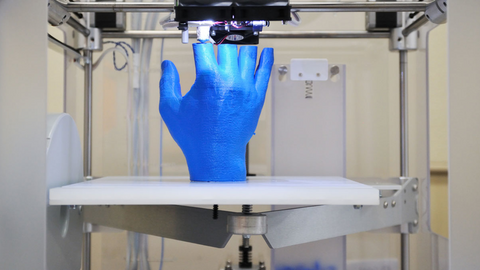By Reeti Shah

Did you know that as of 2013, most hearing aids in the world are made using 3D printing?
But what exactly is 3D printing?
It’s a technology used to transform a digital model into a physical three-dimensional object by printing one layer of material at a time. Any object can be made layer-by-layer on the special platform of the machine. What makes 3D printing so unique is that it uses a minimal amount of resources, allowing for fast and inexpensive production.
To begin 3D printing an object, it’s important to have a digital 3D model of the object. This model is sliced into two-dimensional slices by the printer’s software, which is then made into a set of digital instructions for the printer to carry out. Depending on the type of 3D printer used, you can print with a range of materials like plastic or metal. 3D printing is beneficial, because (1) it helps produce complex shapes, (2) it has very low start-up costs and (3) it allows for easy customization of what you want printed.
Here are some industries that have embraced this innovative technology:
Automotive
In the automotive industry, 3D printing is mainly used for rapid prototyping and improving existing models. Usually, making a prototype would require the same long and expensive process as making the final product. However, 3D printing has been useful in speeding up the process of prototyping. Additionally, some automobile companies have even used 3D printing to improve parts of their existing cars. For example, Volkswagen recently recreated its 1962 Microbus by improving certain parts - i.e. the hubcaps and cast aluminum wheels - through 3D printing. Another example is Bentley, who used advanced 3D printing techniques to make the grille, side air vents, door handles and exhausts more detailed in the Bentley Speed 6.
Medical
3D printing also has many applications in medicine. 3D bioprinters, which can layer cells to create tissues and organs, are commonly used in medical research. Researchers at the Rensselaer Polytechnic Institute and the Yale School of Medicine were able to successfully 3D print skin-like structures and transplant them onto a special type of mouse. This transplanted skin was able to connect and communicate with the mouse’s vessels. This research is exciting as it points towards a future in which 3D bioprinting can be used to make customized health solutions for individuals based on their unique issue.
Architecture/Real Estate
This technology has even been used to print homes! ICON BUILD is a company in Texas that actually uses 3D printing to create homes. This company wants to not only change conventional approaches to building houses, but also provide affordable housing all over the world. It recently built the first 3D home in the United States in Austin, Texas. Additionally, it has partnered with New Story (a non-profit that is trying to provide housing to people all over the world) to build the first 3D printed community of houses in Latin America. To create these houses, ICON uses a Portland Cement-based mix. Despite the fact that they are printed layer by layer, these homes are actually more resilient than normal homes and can withstand extreme weather conditions. 3D printing technology has helped in making the process of building houses faster and more affordable.
As 3D printing advances and is being introduced into more and more industries, it has enormous potential in improving the lives of numerous people. By increasing the rate of innovation and encouraging companies to create and test their ideas faster, 3D printing is beginning to revolutionize the world as we know it.
Sources:
11. https://www.nationalgeographic.com/magazine/2018/03/explore-wellness-3D-printing-body-parts/#close
Editor: Judy Zhang













Comments